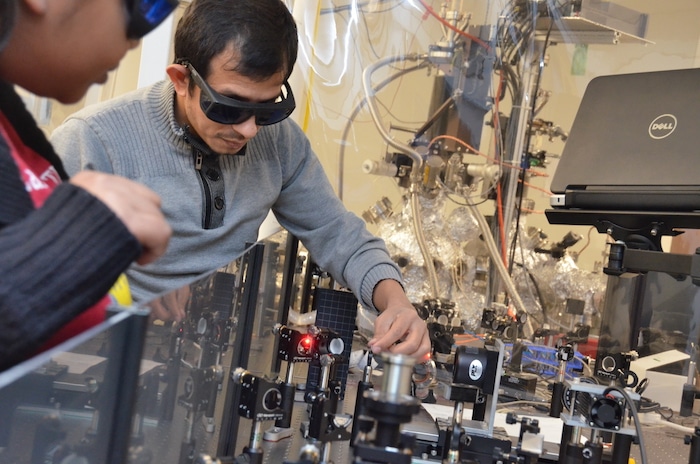Jul 17 2019
Imagine using a simple inkjet printer for printing electronic devices, or painting a solar panel onto a building’s wall.
 Graduate student Tika Kafle (facing camera) works on the time-resolved photoemission spectroscopy setup. (Image credit: Cody Howard/University of Kansas)
Graduate student Tika Kafle (facing camera) works on the time-resolved photoemission spectroscopy setup. (Image credit: Cody Howard/University of Kansas)
Such innovative technologies can considerably reduce the cost of producing electronic devices and, at the same time, provide new methods to incorporate them into people’s day-to-day lives.
Over the last 20 years, a kind of material known as organic semiconductors, fabricated from polymers or molecules, has been created for such purposes. However, certain characteristics of these materials present a significant problem that tends to restrict their extensive use.
In these materials, an electron is usually bound to its counterpart, a missing electron known as ‘hole,’ and can’t move freely. So-called ‘free electrons,’ which wander freely in the material and conduct electricity, are rare and can’t be generated readily by light absorption. This impedes the use of these organic materials in applications like solar panels because panels built with these materials often have poor performance.
Wai-Lun Chan, Associate Professor, Department of Physics and Astronomy, University of Kansas
Due to this complication, “freeing the electrons” has been the target for producing organic semiconductors for light sensors, solar cells, and several other optoelectronic applications, Chan said.
Now, a couple of physics research groups at the University of Kansas (KU), headed by Hui Zhao, professor of physics & astronomy, and Chan have successfully created free electrons from organic semiconductors when integrated with one atomic layer of molybdenum disulfide (MoS2)—a newly identified 2D semiconductor.
Through this introduced 2D layer, the electrons are able to escape from “holes” and thus move freely. The study results have been recently reported in the Journal of American Chemical Society, a prominent journal in chemistry and interfacing fields of science.
In the last several years, a number of scientists have been exploring ways to generate free charges effectively from hybrid organic-2D interfaces.
One of the prevailing assumptions is free electrons can be generated from the interface as long as electrons can be transferred from one material to another in a relatively short period of time—less than one-trillionth of a second.
Wai-Lun Chan, Associate Professor, Department of Physics and Astronomy, University of Kansas
Chan continued, “However, my graduate students Tika Kafle and Bhupal Kattel and I have found the presence of the ultrafast electron transfer in itself is not sufficient to guarantee the generation of free electrons from the light absorption. That’s because the ‘holes’ can prevent the electrons from moving away from the interface. Whether the electron can be free from this binding force depends on the local energy landscape near the interface.”
According to Chan, the electrons’ energy landscape can be perceived as a topographic map of a mountain.
“A hiker chooses his path based on the height contour map,” he stated. “Similarly, the motion of the electron at the interface between the two materials is controlled by the electron energy landscape near the interface.”
The findings made by Zhao and Chan will help in developing standard principles on how to engineer the “landscape” to free up the electrons in such kinds of hybrid materials.
The researchers made this discovery by integrating two extremely complementary experimental tools based on transient optical absorption in Zhao’s laboratory and ultra-fast lasers, time-resolved photoemission spectroscopy in Chan’s laboratory. These two experimental setups are situated in the basement of the Integrated Science Building.
Kafle utilized an ultra-short laser pulse in the time-resolved photoemission spectroscopy experiment. This laser pulse exists only for 10-quadrillionths (10-14) of a second to activate the electrons’ motion. The benefit of using such a short pulse is that the scientist accurately knows the beginning time of the electron’s journey.
Kafle subsequently utilized another ultra-short laser pulse to strike the sample again at a precisely controlled time in relation to the initial pulse. This second laser pulse is sufficiently energetic to displace these electrons from the sample.
By determining the energy of these electrons (presently in a vacuum) and also applying the principle of energy conservation, the investigators successfully figured out the electrons’ energy before they were knocked out and thus exposed the electrons’ journey since they were bombarded by the initial pulse.
This method effectively resolved the energy of the excited electrons as it travels across the interface following the absorption of light.
Considering the fact that only electrons close to the sample’s front surface can be discharged by the second pulse, the electron’s position in relation to the interface is also demonstrated with atomic precision.
During the measurements of the transient optical absorption, KU graduate Peymon Zereshki and Peng Yao (a visiting student), both supervised by Zhao, also employed a two-pulse approach, with the first laser pulse triggering the electron motion in the same manner. Yet, in the researchers’ measurements, the second laser pulse performs the trick of tracking electrons by identifying the fraction of the second pulse that gets reflected from the sample, rather than knocking out the electrons.
Because light can penetrate a longer distance, the measurement can probe electrons in the entire depth of the sample and therefore provide complementary information to the first techniques that are more ‘surface sensitive. These detailed measurements enabled us to reconstruct the trajectory of the electron and determine conditions that enable the effective generation of free electrons.
Hui Zhao, Professor, Department of Physics and Astronomy, University of Kansas
The collaborative study from the two research groups will give a blueprint on the most optimized way to create interfaces that can convert light into electrical current with excellent efficiency.
Both research groups are funded by the National Science Foundation through a CAREER Award (Chan) and a Condensed Matter Physics Award (Zhao).